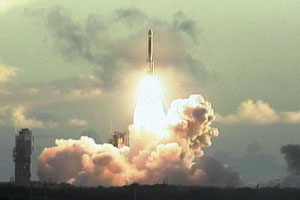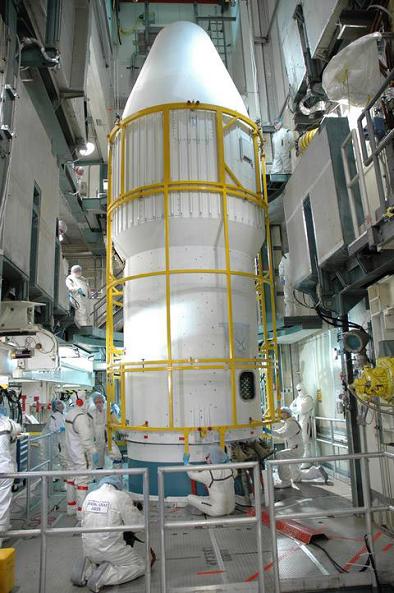The DAWN spacecraft that would attack Vesta and Keres took off on its way

16: 00 Update
The ground controllers of the NETWORK deep space network received live signals from the DAWN spacecraft, and began to assess its condition. In doing so, it successfully begins its journey towards the asteroid belt, after all the stages of the launch, including the separation of the second and third stages, have passed safely. The spacecraft will begin orbiting Vesta in 2011 and Ceres in 2015.
14: 00 Update
NASA's DAWN spacecraft was launched today (13:34 Israel time) on a Delta 2 rocket for the first part of its journey to the asteroid belt.
Nestled safely inside the nose of the rocket, the spacecraft lifted off in the smoke and fire of the Delta 2 through the atmosphere into orbit around Earth.
The nose cap fell off as planned, giving the spacecraft its first taste of the vacuum of space. The telemetry engineers at the Air Force Base in Cape Canaveral are evaluating the impact of the launch so far and they are waiting for the second and third stages to drop. The DAWN mission will traverse the inner Solar System and study asteroid Vesta and the dwarf planet Ceres, two of the largest asteroids in the asteroid belt between Mars and Jupiter.

Update 27/9/200, at 00:00
NASA's launch and flight crews are in the final stages of preparations for the planned Dawn launch on September 27th - Launch 17-B at Cape Canaveral Air Force Base. The Shahar spacecraft will venture into the heart of the asteroid belt, where it will record in detail the giant rocky asteroid Vesta, followed by the dwarf planet Ceres, which is even larger than Vesta.
"If you live in the Bahamas, this will be the only time you can tell your neighbor, in all seriousness, that the dawn will rise in the west," said Project Dawn director Cur Patel of NASA's Jet Propulsion Laboratory in Pasadena, California. "If the weather is good, we will get the green light to launch on Thursday morning - shortly after dawn."
The dawn launch window on September 27 is between 7:20 and 7:49 am, according to Eastern Daylight Time (13:20 to 13:49 Israel time). At the moment of launch, the Delta II main engine of the first stage was ignited, along with six of its nine boosters, which work on solid fuel. The remaining three boosters will be ignited in flight, after the first six are consumed. The main engine of the first stage will burn for 4.4 minutes. In the second stage, the dawn will remain in a circular parking orbit at an altitude of 185 kilometers, for a little less than nine minutes. About 56 minutes after launch, the rocket's third and final stage will begin, lasting about 87 seconds. When the third stage is over, power converters and springs on the launch vehicle will separate the spacecraft from the launch vehicle.
"After undocking, the spacecraft will perform an automated sequence of operations, including stabilizing the spacecraft, activating flight systems and deploying its two massive solar arrays," Patel said. "Only then will the spacecraft activate its transmitter and establish contact with Earth. We expect to receive the signal between an hour and a half to three and a half hours from the moment of launch."
Dawn's mission is to study Vesta followed by Ceres, since these two giants of the asteroid belts have witnessed so much of our solar system's history.
"The visit to Busta and Kress will make it possible to explore the contrasts in outer space," said Christopher Russell, Dawn's principal investigator, at the University of California, New Angeles. "The first is rocky and represents the building blocks that make up the planets in the inner part of the solar system. The other may be made of ice and thus represent the outer planets. Despite their sharp contrasts, these two celestial bodies are right in the same neighborhood. This is one of the mysteries that Shahar hopes to solve."
Using the same spaceship to observe the various celestial targets is smart, and not just from the financial aspect. This makes scientific sense. By using the same set of instruments in two different locations, the scientists can draw up more precise comparisons and contrasts. Dawn's scientific toolkit will measure mass, shape, surface topography and tectonic history, elemental and mineral composition, and scan for water-bearing minerals. In addition, the gravitational fields of the celestial bodies will be measured with the help of the Dawn spacecraft itself, and the way it circled around Lusta and Keres.
"Understanding the conditions that lead to the formation of planets is one of NASA's goals in its research missions," said David Lindstrom, Dawn Program Scientist at NASA Headquarters in Washington. "The scientific data that will be obtained from Vesta and Makres will be able to solve many of the mysteries surrounding the formation of the rocky planets, including Earth."
Before all of this unraveling can happen, Dawn must reach the asteroid belt and its first target - Vesta. This process will take four years, beginning with the launch and through the ignition of three of the most efficient engines in NASA's space shuttle - ion propulsion engines. Using a complex mix of electric power coming from the solar cells and xenon gas, these economical engines will operate for months in turn, propelling the dawn forward and correcting its course. The engines will die only after eight years - and almost 8 billion kilometers. Together, all three ion propulsion engines will operate for 50,000 hours (over five years) - a new record for spacecraft.
Dawn's mission to the asteroid Vesta and the dwarf planet Keres was agreed upon by the JPL supervisor, for NASA's Space Mission Directorate in Washington, DC. JPL is a division of the California Institute of Technology in Pasadena. The University of California, Los Angeles is responsible for the Dawn Science Mission. Other scientific partners include the Los Alamos National Laboratory in New Mexico, the Max Planck Institute for the Study of the Solar System in Katlenburg, Germany, and the Italian National Institute of Astrophysics in Rome. The Dawn spacecraft was designed and built by Orbital Sciences Corporation.

6 תגובות
Photos from the launch: http://www.nasa.gov/mission_pages/dawn/multimedia/dawnlaunchgallery.html
The links to the launch video, along with a video explaining the mission of the Dawn, can be found at:
http://www.nasa.gov/mission_pages/dawn/main/index.html
on the right side of the screen.
Please ask Roy Tsuga where you can see the video of the launch
We hope you arrive safely. In the asteroid belt area there may be small bodies that could endanger the spacecraft's serviceability. Let's very much hope that luck will play in favor of science
The spaceship will take four years to reach Lusta, that is around 2011-2012.
in 2011 and 2015
Please ask Roy Tsuna when the spacecraft arrived at the asteroids